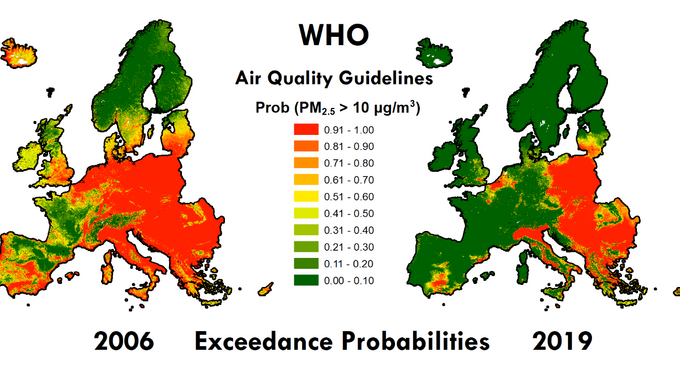A new study by Swiss TPH used robust spatio-temporal methodology to show the reduction in air pollution across Europe from 2006-2019 and found that while exposure rates have significantly declined across Europe the past 14 years, there are large parts of the continent where the World Health Organization guidelines on air pollution are still not met. The results were published in the journal Environmental Science & Technology.
Air pollution – both ambient (outdoor) and household (indoor) – is the biggest environmental risk to health, with ambient air pollution alone killing around 3 million people each year. Air pollution continues to rise at an alarming rate, with death tolls surpassing those of war, malaria and cigarettes according to recent studies.
A new study by Swiss TPH used Bayesian geostatistical modelling methodology to quantify spatio-temporal particulate matter air pollution trends in Europe during 2006-2019 for the first time. The results have shown that PM10 and PM2.5 concentrations across Europe declined by 37% and 39% respectively. The study was published in the journal Environmental Science & Technology.
This study provides data-driven evidence on air pollution and health to assist policy makers in the decision-making process and to develop new, locally adapted environmental protection and public health strategies in Europe.
“With our estimates, we can determine areas in Europe that exceed the air quality guidelines' thresholds set by the European Union and the World Health Organization and compare trends over time and between the countries,” said Anton Beloconi, scientific collaborator at Swiss TPH. “What we found is that the number of people in Europe exposed to PM10 levels above the WHO thresholds between 2006 and 2019 decreased from 78% to 28%; and those exposed to PM2.5 from 91% to 54%.”
Improved air pollution levels, but work still remains
“The Bayesian modelling framework allowed us to make probabilistic statements about areas exceeding the international air quality thresholds," said Penelope Vounatsou, head of Biostatistics Unit at Swiss TPH. "There is a clear improvement of air quality throughout Europe and the requirements of EU threshold concentrations are met in most of the continent, however, there is much work to be done in order to achieve the more stringent WHO guidelines.”
Bayesian modelling and analysis at Swiss TPH
The Bayesian Modelling and Computation group at Swiss TPH carries out research in statistical methodology for modelling large space-time health and environment data. Key applications include disease monitoring, evaluation and surveillance, estimation of environmental exposures and disease burden, assessment of the effectiveness of health interventions and policies, estimation of climate change impacts and spatial sampling designs. The expertise of the group is valuable to policy and decision makers as well as to environmental agencies and health organisations, as it provides technical support in building accurate data-driven evidence on health and the environment at national, regional and global levels.
A leading institute in the field of air pollution and health
Swiss TPH is a leading research institute in the field of air pollution and health. Experts monitor air quality and employ spatio-temporal modelling methods to estimate exposure to pollutants and its impact on public health, advise policy-makers to formulate evidence-based health policies, and participate in the steering board of the WHO Air Quality Guidelines. Starting in 2022, Swiss TPH will also collaborate with the European Environment Agency as part of a consortium focusing on human health and the environment.
